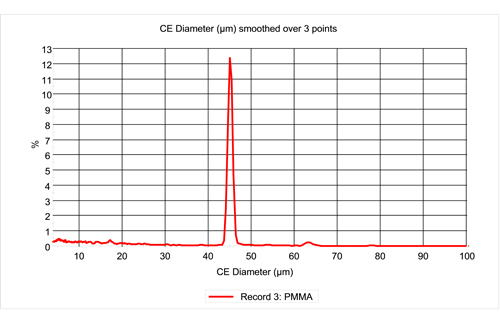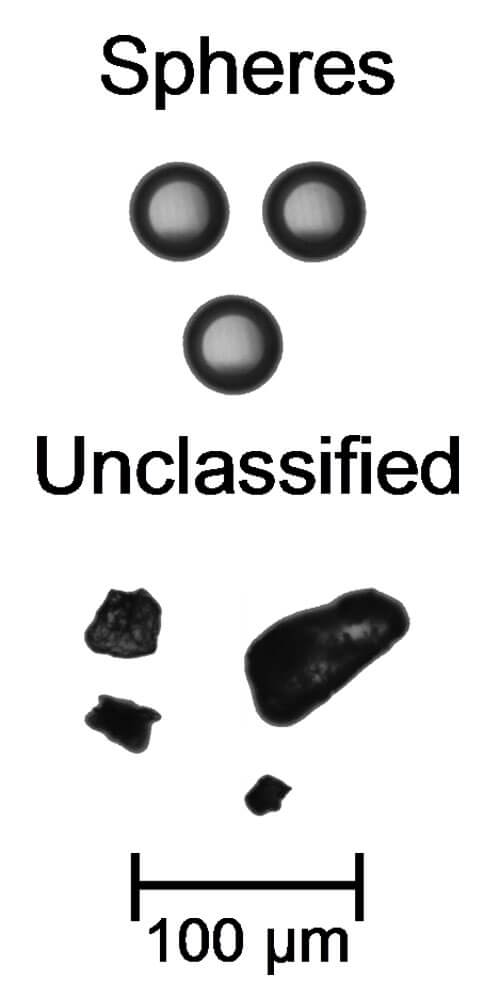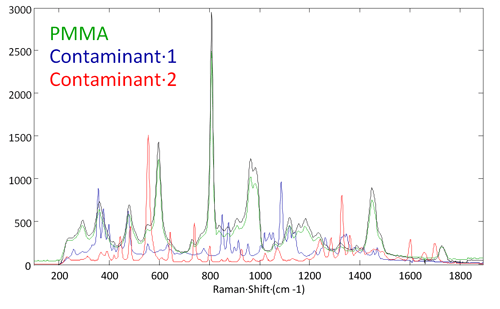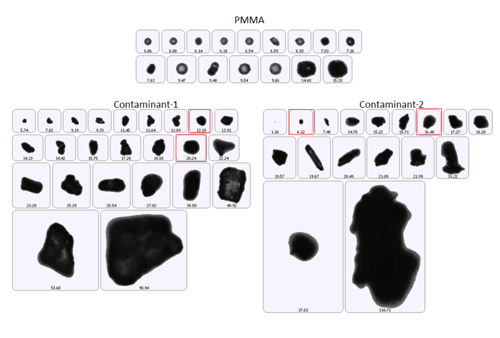Raman spectra of individual particles of interest are collected and compared to a library of known spectra. For this application the library contains only a few components - PMMA, and the two contaminants types. Large libraries (user created or commercially available) may also be employed, if the range of potential chemical components is broad. Particle spectra acquired are pre-processed to minimize baseline variation and correlated with library spectra that have been similarly pre-processed. The more similar a particle spectrum is to a library component, the closer the correlation coefficient is to 1.

Introduction
Careful control of particle size and shape is extremely important in the fabrication of complex, high value products. The Morphologi G3-ID automated particle characterization system is ideally suited to collect and analyze these parameters. Equipped with a Raman microprobe, the Morphologi gains the additional ability to chemically identify particles. Knowing this can be critical in troubleshooting out-of-specification products, answering the question: 'Are outliers misshapen particles of the correct material or foreign contaminants?'Method
A sample consisting primarily of PMMA spheres (~45 micron diameter) was dispersed using the Morphologi G3-ID's integrated sample dispersion unit. The sample was contaminated with small levels of two known contaminants. Automated particle imaging was performed at 10X magnification, 8,837 particles were characterized in 15 minutes. The resulting circular equivalent diameter distribution of all characterized particles is shown in Figure 1.Figure 1: Circle equivalent (CE) diameter distribution for the PMMA sample.
Results
The majority of particles in the sample are 45 microns in diameter, with a secondary peak near 65 microns (touching spheres). Additional particle populations, both larger and smaller, are present. This suggests outlier particles corresponding either to misshapen PMMA particles or chemically distinct contaminants. Figure 2 shows images of ~45 micron spheres along with several smaller non-spherical particles. There is a clear difference in the particle shape between the two. The spheres shown in Figure 2 have a light region in the center of the image. The standard deviation in brightness across a particle (SD) is one of the parameters available for characterization in the Morphologi software. A class named "Spheres" is defined, including all particles with a circularity > 0.92 and an intensity standard deviation (SD) > 36. Particles outside of these ranges remain "unclassified" at this point in the analysis.
Figure 2: Images of spherical and non-spherical particles in sample The chemical identity of individual particles provided by the Raman microprobe may be used as a definitive parameter for the differentiation of unclassified particles. First, for confirmational purposes, spectra of a subset of the particles in the "Spheres" class were collected. As expected, all had correlation coefficient values near 1.0 for PMMA. A representative Raman spectrum of a PMMA particle (black trace) along with the library component spectra are shown in Figure 3. More interestingly, a subset of the unclassified particles was analyzed using Raman. Figure 4 shows example images of these particles - i.e. those not classified as Spheres using morphological - not chemical - parameters. As expected, the two contaminants make up the bulk of this population. Of additional interest though, is the presence of small, misshapen spheres chemically identified as PMMA, previously characterized as "unclassified". Contaminant 1 and 2 (large and non-spherical particles) are easily distinguished from 45 micron PMMA spheres using morphological parameters only. However, if one is interested in classifying misshapen PMMA particles, morphology alone is insufficient. Although the misshapen spheres tend to be more circular than the contaminant particles, this is by no means definitive. Example contaminant particles that are morphologically indistinguishable from the misshapen PMMA spheres are highlighted by red boxes in Figure 4. The ability to unequivocally determine the chemical ID of "misshapen PMMA" contaminants is possible only with the Raman microprobe. Spectroscopic classification information may be used to confirm and refine class definitions, in addition to creating new ones.

Figure 3: Raman spectra of PMMA particle (black trace) along with the library components: PMMA (green), Contaminant 1 (blue) and Contaminant 2 (red)

Figure 4: Images of particles chemically identified as PMMA, contaminant 1 or contaminant 2. Below each particle is its corresponding CE diameter in microns
Conclusions
The Morphologi G3-ID enables simultaneous physical and chemical characterization of particle samples. Chemical identification can determine if outlier particles are the correct material but misshapen due to production problems or if they are genuine foreign contaminants. This provides indispensible information in correcting the problem, and reducing the incidence of out-of-specification batches.Malvern provides the materials and biophysical characterization technology and expertise that enables scientists and engineers to investigate, understand and control the properties of dispersed systems. These systems range from proteins and polymers in solution, particle and nanoparticle suspensions and emulsions, through to sprays and aerosols, industrial bulk powders and high concentration slurries. Used at all stages of research, development and manufacturing, Malvern’s instruments provide critical information that helps accelerate research and product development, enhance and maintain product quality and optimize process efficiency. Our products reflect Malvern’s drive to exploit the latest technological innovations. They are used by both industry and academia, in sectors ranging from pharmaceuticals and biopharmaceuticals to bulk chemicals, cement, plastics and polymers, energy and the environment. Malvern systems are used to measure particle size, particle shape, zeta potential, protein charge, molecular weight, mass, size and conformation, rheological properties and for chemical identification, advancing the understanding of dispersed systems across many different industries and applications. www.malvern.com Material relationships http://www.malvern.com/en/ portal@malvern.com





